I’ve been wanting to write a post about using music fonts for a long time. Finally, here it is! If you have been wondering how you can create your own music worksheets/resources, this guide will help you get started.
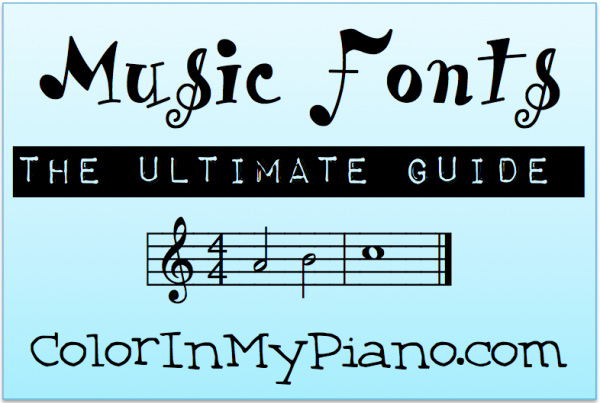
For my worksheets/materials, I use graphics exported from Finale about 30% of the time, and music fonts the other 70% of the time. The great thing about using music fonts is that anyone can use them, without having to buy an expensive program like Finale. However, using music fonts is a little more complicated than you might think. This post will attempt to demystify the process and point you to some links and resources.
Using Music Fonts
If you own a music engraving software like Finale or Sibelius, then guess what: You already have music fonts on your computer! Using Fontbook (on Mac computers) or “Fonts” in the Control Panel (PCs), you can view all the fonts installed on your computer.
If you don’t have any music fonts on your computer, you can find them online. Then you must download and install them onto your computer. It’s pretty easy to install fonts, but you can find tutorials online that can lead you through the process if you need some help (just Google it).
That is the easy part. Once the music font is installed on your computer, it’s a little bit tricky to figure out where the various notes/symbols are located within the font. If you open a new document in Microsoft Word (or whatever word processing software you use), select a music font, and press some random letters of the alphabet, you will see some of the symbols contained in the font. You can guess and begin to memorize where the various notes/symbols are, but that is time-consuming and somewhat impractical. Besides, many of the characters you might need are not represented by the buttons on your keyboard. For example, the currency symbol for Yen could be the barline. To insert the Yen symbol, normally you have to go to “Insert A Symbol” in Microsoft Word because it’s deep in the font somewhere. So, how do you know where the characters you need are? This is where character maps come in.
Character Maps
For some of the fonts listed below, you will find character maps available to view on the website or as a pdf download. A character map is a chart that shows all the characters of a font, and if you are lucky, where they are all located!
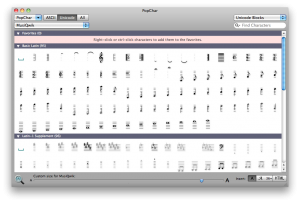
Some computers have built-it character map utilities. Macs have something called the “Character Viewer,” but it is only mildly helpful because it shows font characters by category across all fonts, rather than allowing you to choose one font to view at a time. PC’s have some kind of character map utility built-in too.
You can also buy separate character map utility software. One such example is PopChar (for Mac; pictured at right). Even the free trial version is helpful in getting an idea of what symbols are included in a font. Some character map utilities come with the ability to insert the symbol you click in directly into the document you are working on. This is the most ideal and convenient way to use music fonts.
Update: Even better than PopChar is Ulta Character Map. It’s an iOS app for Mac computers that costs $10. Worth every penny!
Music Fonts
Here’s a complete list of available music fonts that I’m aware of. You may be able to find these fonts and their character maps by googling them. Just be sure to follow the copyrights for the fonts you download. For example, if you plan to sell the worksheets/materials you create using any of these music fonts, you first must check that the music font has a commercial-use license. Some of these fonts are free only for personal/educational use.
The fonts in this list with asterisks are the ones I highly recommend. If you know of other music fonts to add to this list, please leave a comment on this post.
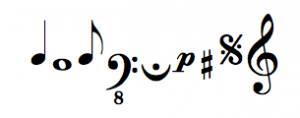 Maestro | Maestro is one of the fonts that comes with Finale. It contains a complete set of music symbols. If you download the free Finale Notepad software from their website (yes, in 2012 they decided to make Finale Notepad available again! This is great if you have student interested in composition), you can get a selection of music fonts that way. Here is a guide from the Finale user manual that shows the keystrokes needed for inserting each symbol.
Maestro | Maestro is one of the fonts that comes with Finale. It contains a complete set of music symbols. If you download the free Finale Notepad software from their website (yes, in 2012 they decided to make Finale Notepad available again! This is great if you have student interested in composition), you can get a selection of music fonts that way. Here is a guide from the Finale user manual that shows the keystrokes needed for inserting each symbol.- Petrucci | comes with Finale. It’s similar to Maestro, but just has a slightly different look. Also available here.
- Engraver | comes with Finale. It’s similar to Maestro and Petrucci. Here is the guide from the Finale user manual that shows the keystrokes needed for inserting each symbol.
 Finale Alphanotes | Finale comes with a variety of other special fonts. One of them is Finale Alphanotes, which provides noteheads with letters inside.
Finale Alphanotes | Finale comes with a variety of other special fonts. One of them is Finale Alphanotes, which provides noteheads with letters inside.- Opus | Comes with Sibelius software. This font is similar to the ones above. View the character map here.
- Helsinki | Comes with Sibelius software. It’s similar to Opus.
- Marl | Another font of music symbols, similar to Maestro. Available here.
- Sonata | A font created by Adobe with a large variety of symbols. To use for commercial use, it costs about $29. There’s also Sonata Thin.
- Sonora | A font of musc characters by Christian Texier. It’s similar to Maestro. Scroll up on Texier’s website page to see the variety of other advanced fonts he has created for electronic music, quarter-tone music, complex percussion music, etc..
- Musical Symbols | Another musical symbols font similar to Maestro.
- ShpFltNat Medium | Another musical symbols font. It includes a few symbols that other fonts are missing, like time signatures (nice looking too), crescendo, decrescendo, and scale degrees.
 StaffClefPitchesEasy | Matthew Hindson has kindly made his fonts available for free! This font is different from the ones above because it is designed to show notes on the staff. You can’t make chords but you can make short examples of single-note melodies. The noteheads are all filled in with no stems.
StaffClefPitchesEasy | Matthew Hindson has kindly made his fonts available for free! This font is different from the ones above because it is designed to show notes on the staff. You can’t make chords but you can make short examples of single-note melodies. The noteheads are all filled in with no stems. *Rhythms | Rhythms is another font by Matthew Hindson. The notes all appear on a straight line, which is perfect for creating rhythms. Time signatures are included too. I highly recommend this font.
*Rhythms | Rhythms is another font by Matthew Hindson. The notes all appear on a straight line, which is perfect for creating rhythms. Time signatures are included too. I highly recommend this font. *MusiSync | This font is by Robert Allgeyer and is similar to Hindson’s “Rhythms” above, but it contains more symbols. It’s great for creating strings of rhythms. My only regret is that the time signature numbers were nicer-looking. View a semi-complete character map here. This font is commercial-use friendly. I highly recommend this font.
*MusiSync | This font is by Robert Allgeyer and is similar to Hindson’s “Rhythms” above, but it contains more symbols. It’s great for creating strings of rhythms. My only regret is that the time signature numbers were nicer-looking. View a semi-complete character map here. This font is commercial-use friendly. I highly recommend this font. *MusiQwik and MusiQwikB | This pair of fonts is also by Robert Allgeyer. It is great for great simple melodies (no chords) on the staff. It also contains clefs, time signatures, key signatures, and a variety of other staff symbols. According to Robert, “You may use the hyphen (-) key to insert a tiny segment of staff, if alignment of the notes is important. Regular sections of staff are inserted using the equal (=) key. Be sure that word wrapping is turned off, or your staff will break in unexpected locations. This font looks best at 24 point size or larger.” MusiQwikB contains sixteenth notes. I highly recommend this font.
*MusiQwik and MusiQwikB | This pair of fonts is also by Robert Allgeyer. It is great for great simple melodies (no chords) on the staff. It also contains clefs, time signatures, key signatures, and a variety of other staff symbols. According to Robert, “You may use the hyphen (-) key to insert a tiny segment of staff, if alignment of the notes is important. Regular sections of staff are inserted using the equal (=) key. Be sure that word wrapping is turned off, or your staff will break in unexpected locations. This font looks best at 24 point size or larger.” MusiQwikB contains sixteenth notes. I highly recommend this font. NoteHedz | Another font by Robert Allgeyer. It’s a simple font with the letter names A-G in the noteheads. There are quarters, eighths, and whole notes, but no way to get half notes (as far as I can tell).
NoteHedz | Another font by Robert Allgeyer. It’s a simple font with the letter names A-G in the noteheads. There are quarters, eighths, and whole notes, but no way to get half notes (as far as I can tell). Lassus | Like MusiQwik, the notes in this font appear on the staff. There are no time signatures. A partial character map can be viewed here.
Lassus | Like MusiQwik, the notes in this font appear on the staff. There are no time signatures. A partial character map can be viewed here.- Bach and Kodaly | Bach is a very advanced and powerful font, but not so easy to use. Kodaly is a simpler version of Bach, but without noteheads. I haven’t figured out how to use these fonts, but you can check out their website to learn more.
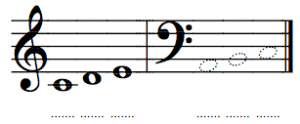 Kodaly (different from the Kodaly font above) | This is a simple font showing the notes on the staff with dotted lines underneath for naming the notes. Also includes traceable notes on the staff, and solfegietto under the staff. It is pictured on the right. There are no time signatures available.
Kodaly (different from the Kodaly font above) | This is a simple font showing the notes on the staff with dotted lines underneath for naming the notes. Also includes traceable notes on the staff, and solfegietto under the staff. It is pictured on the right. There are no time signatures available.
More Resources:
- StaffWriter and SingASign | These fonts are available to purchase on a CD from macmusicfonts.com. I haven’t tried them myself, but the fonts look pretty comprehensive and I’ve seen other teachers recommend them.
- Here’s a huge list of paid music fonts that can be used in word processing software and are compatible for use with Finale.
- A font for notating djembe music!
- Paid fonts of the piano keys, for showing fingering, showing chords, or showing names of keys.
- A paid font of the neumes used for notation during the 15th – 17th centuries. Very cool!
Tutorials:
- Click here to view my video tutorial about how to use the MusiSync and Rhythms music fonts using the program Microsoft Publisher.
- Click here to view my video tutorial about how to the use the MusiQwik and StaffClefPitchesEasy fonts.
- Do music fonts seem too complicated? Download my free png files of music symbols and drop them into a program like Microsoft Publisher to make your own worksheets. It’s easy! Watch the tutorial here.
Good luck with your music font creations, and let me know what you create!


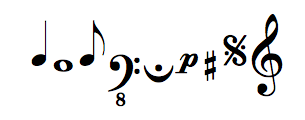
Joy, you are amazing!!! Thank you so much for sharing this–I had been wondering about how to create worksheets with notes/staff/keyboard for so long!
You’re welcome! 🙂
Joy, this is absolutely wonderful! Thank you for taking the time and energy to compile this wonderful list of music fonts, I have to check all of these out! 😉
Thanks so much for this! I’m sure I will be using it in the future!
Wow Joy, this is amazing!!! Thank you so much for this wonderful resource. Will DEFINITELY be referring to this in the future. You rock!
Joy-thank you once again for all the hard work you do that makes my life as a piano teacher so much easier. I really appreciate this info on music fonts.
You’re welcome, Alissa! Thanks for your comment.
Thanks Joy! Can’t wait to get busy and explore these music fonts.
Hi Joy! I really enjoyed this post– I had been wondering about this for a while! I was wondering— could you sometime possibly post something about the steps you take to create your worksheets? Thank you for this amazing website! ~Tianna
Great idea, Tianna. I will definitely consider this. Maybe the next time I have a worksheet idea, I’ll blog about the process with some screenshots to accompany the post. 🙂
This is wonderful! Turns out that I have music fonts on my computer already! Thank you! I agree with Tianna – I’d love to see how you create your worksheets.
Thanks for a great post Joy and congratulations on your site. I agree that the Robert Allgeyer fonts are great too- you’ve made a very informative blog on fonts.
Thanks! I have installed “Rhythms” and it is so quick to use! This will be so handy.
Dear Joy
I was looking for music fonts and got directed to your website. I am amazed by the amount of free work you are generously giving to everybody. I am an old retired man, but I have learned a few things wandering thru your blog. I ask myself what is steaming people that act in such an altruistic manner in a world like the one we share! May be you are a religious person or may be, simply, you are a good person. Thank you for all and I hope life will treat you well. Regards.
JAFC
Thanks for your kinds words!
Hello,
I know several other music fonts, so here is a list:
MUSEGRAPH Fonts (www.musegraph.com):
Berlin | A vertical music font for naming instruments. Unnecessary for Sibelius 7 users, since you can do that with the program itself. I don’t know about Finale.
Zurich | Just a font with many symbols. Seems pretty useless for Finale and Sibelius users.
Firenza – medieval font | Now, this is interesting. It has many glyphs you hardly see in any music font. On the other hand, it’s only useful for users who write a lot of medieval stuff, and then from a certain period.
Paris | Based on the font used in Lilypond. A beautiful font, but I really don’t like the G-clef.
Oslo | Different, too, but nothing too special.
Stockholm | Similar to Maestro, so if you have Maestro, well this would be a waste.
Vienna* | My favorite Musegraph font. Recommended
KLEMM MUSIC TECHNOLOGY (http://www.klemm-music.de/notation/november)
November* | Wonderful. Lot’s of black, thick black, yummy. It’s my favorite font. Sibelius has some problems with it, though. I needed to custom the font to get it to work. It is pricey, but it’s well worth it.
Gregorian | The examples look neat, but it’s pretty buggy and just not worth it for its ridiculous price.
Caeciliae* (http://marello.org/caeciliae/):
A beautiful Gregorian font. And, it’s ABSOLUTELY FREE!!!
It need some getting used to, but you can get great results with it!!! Doesn’t work in either Sibelius or Finale; it’s made for notepad (yes, friggin’ notepad).
Cheers,
Mano
Dear Joy
I have been using Noteworthy Composer on a PC but have now only got a Mac laptop and can’t use Noteworthy Composer any more. I have converted my NWC files to MIDI and imported them to Finale but the fonts are different and I don’t know how to fix it. Would you have any suggestions. I’m stumped as I don’t know anything about fonts. When I google stuff I can’t understand the techno babble.
In hope that you have some insights…
Dallas de Brabander
I would contact Finale directly about this, and see if they have any advice for you! You could also try posting in a Finale forum — sometimes other users can be very helpful. Sorry I can’t help more. :\ Good luck!
Hi Joy,
Love your site and thanks for linking to mine in the link “Paid fonts of the piano keys”
Unfortunately I’ve move my font site to… http://www.funfingeringfonts.com
If you’d be so kind to update the link I’d be so very grateful. Send me your email and I will send you a free copy of the Piano Fingering Fonts as a thanks!
Tristan
Hi Tristan, Thanks for letting be know about the link update!
Excellent list! Thank you! A couple of corrections:
• Under More Resources: the last item (Whitenow) isn’t neumes.
• In Manuel Gutierrez Roj’s comment, Firenza isn’t medieval either (despite what it says on the site).
Both are late Renaissance – early modern notation.
• Besides Caeciliae mentioned by Mano, another font that can make neumes is the free Meinrad family of fonts.
Yes, I found it strange, why it’s called medieval.
Thanks for the link. Melody, especially, looks amazing!!!
Hi Joy,
Thank you so much for the font information! I am so excited to make all kinds of new sheets!
This is a fantastic resource that saved my butt today while updating my method books 😉 Thanks Joy!
Glad it helped, Jennifer! 😉
Thank you so much!!! I’ve been searching for it for hours :DDDD
Really, This is the best article I found. THANK YOU!!!
Thank you Joy for this wonderful compendium of info and links about musical fonts. I have taught many years: guitar, piano, flute, theory, composition and improvisation and am writing a little short book on improvisation ideas at the urging of my students from years past.
Having access to these fonts has made the book writing much easier and enjoyable.
Thank you thank you thank you!
PS: I didn’t realize that my Finale fonts were included in my Microsoft Office font list – duh!
Hi Joy, thanks a lot for all the information you have made. It’s very useful.
I’ve got some problem with MusiQwik. Do you know how to type accidentals ? I didn’t find the way to add it. For example : to add # in the first space of stave.
I’ve download the character map, but can’t type many accidentals. 🙁
In the “insert symbol” for menu, it just have some accidentals.
Just FYI, i’m using MacBook.
Thanks a lot..
Hi Joy,
thanks for this page !
Did you know the online music font comparison from Elbsound.studio ? It contains four musical examples rendered in 150 music fonts and makes it easy to select your preferred music font.
Jan
Hello! Could you tell me which font created the words “Music Fonts” in your blog header? I’m searching for that font. Thank you!
Hi John! That font is mentioned in this other blog post: 10 Fun & Free Musical Fonts. It’s called LD Music.
I’m looking for a treble clef that students can trace. Where can I find that font?
An amazing list of music fonts.
Keep it up!!
Hello. I realize I found your post a couple
years after you originally published it.
I wanted to thank you for sharing all the
information. I’m putting together
a music theory book, and thus far
I’ve drawn most of my own material.
At some point, I’d love to get some of
the software you referenced. Again,
thank you for sharing!